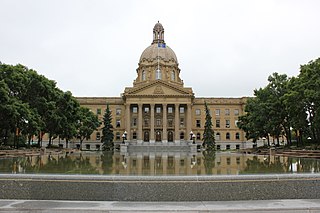The British Columbia Hydro and Power Authority, operating as BC Hydro, is a Canadian electric utility in the province of British Columbia. It is the main electricity distributor, serving more than 4 million customers in most areas, with the exception of the City of New Westminster, where the city runs its own electrical department and portions of the West Kootenay, Okanagan, the Boundary Country and Similkameen regions, where FortisBC, a subsidiary of Fortis Inc. directly provides electric service to 213,000 customers and supplies municipally owned utilities in the same area. As a provincial Crown corporation, BC Hydro reports to the BC Ministry of Energy, Mines and Low Carbon Innovation, and is regulated by the British Columbia Utilities Commission (BCUC). Its mandate is to generate, purchase, distribute and sell electricity.

The Manitoba Hydro-Electric Board, operating as Manitoba Hydro, is the electric power and natural gas utility in the province of Manitoba, Canada. Founded in 1961, it is a provincial Crown Corporation, governed by the Manitoba Hydro-Electric Board and the Manitoba Hydro Act. Today the company operates 16 interconnected generating stations. It has more than 527,000 electric power customers and more than 263,000 natural gas customers. Since most of the electrical energy is provided by hydroelectric power, the utility has low electricity rates. Stations in Northern Manitoba are connected by a HVDC system, the Nelson River Bipole, to customers in the south. The internal staff are members of the Canadian Union of Public Employees Local 998 while the outside workers are members of the International Brotherhood of Electrical Workers Local 2034.

Duke Energy Corporation is an American electric power and natural gas holding company headquartered in Charlotte, North Carolina. The company ranked as the 141st largest company in the United States in 2024 – its highest-ever placement on the Fortune 500 list.

The electricity sector in Canada has played a significant role in the economic and political life of the country since the late 19th century. The sector is organized along provincial and territorial lines. In a majority of provinces, large government-owned integrated public utilities play a leading role in the generation, transmission, and distribution of electricity. Ontario and Alberta have created electricity markets in the last decade to increase investment and competition in this sector of the economy.

TransAlta Corporation is an electricity power generator and wholesale marketing company headquartered in Calgary, Alberta, Canada. It is a privately owned corporation and its shares are traded publicly. It operates 76 power plants in Canada, the United States, and Australia. TransAlta operates wind, hydro, natural gas, and coal power generation facilities. The company has been recognized for its leadership in sustainability by the Dow Jones Sustainability North America Index, the FTSE4Good Index, and the Jantzi Social Index. TransAlta is Canada's largest investor-owned renewable energy provider.

Panda Energy International, Inc. was an American privately held company headquartered in Dallas, Texas which constructs, maintains and operates environmentally friendly power plants. The organization has been recognised by Newsweek magazine as one of the top ten eco-friendly energy companies in America. As of 2010, it has been affiliated with Panda Power Funds. Panda Energy informed its shareholders that it would shut down at the end of 2018.

The electricity policy of Alberta, enacted through several agencies, is to create an electricity sector with a competitive market that attracts investors, while providing consumers with reliable and affordable electricity, as well as reducing harmful pollution to protect the environment and the health of Albertans, according to their 2022 website.

Wolfe Island Wind Farm is a large wind farm project located on Wolfe Island, Ontario. The wind farm became operational on June 29, 2009. It is owned and operated by Canadian Hydro Developers, Inc., through its subsidiary Canadian Renewable Energy Corporation (CREC). The power will be purchased by Hydro One for distribution to consumers.
Marathon Capital is an American boutique investment bank delivering financial advice to the global energy, infrastructure markets, and clean economy. Marathon Capital specializes in the sale and financing of companies, portfolios and assets within these markets.

Capital Power is a North American independent power generation company based in Edmonton, Alberta, Canada. It develops, acquires, owns and operates power generation facilities using a variety of energy sources.
Innergex Renewable Energy is a developer, owner and operator of run-of-river hydroelectric facilities, wind energy, and solar farms in North America, France and South America. While many of the firm's operational assets are located in its home province of Québec, it has expanded into Ontario, British Columbia, and Idaho, as well as Chile and France
Cloudworks Energy Inc. was a private, Vancouver-based run-of-river hydro developer formed in 1999. The firm's principals developed the 33MW Miller Creek run-of-river project and the 49.9MW Rutherford Creek project. In 2011 Innergex Renewable Energy acquired Cloudworks Energy Inc.
Independent power producer (IPP) projects have had a significant presence in British Columbia since the 1980s. Their relationship with BC Hydro grew from the province's need to supply growing energy demands and implementation of the 2002 Energy Strategy, which mandated that BC Hydro would purchase its energy supply from IPPs rather than generating the supply itself. There are a variety of power projects in BC, with the most popular being hydroelectricity and biomass projects. In recent years, more attention has been placed on the environmental effects of IPP projects and the social implications it has to residents living around the project development sites. Despite the decline in demand for new IPP projects, in 2016 they supplied 20,000 GWh, one-third of BC Hydro's total.







